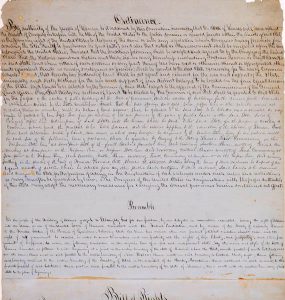The third Kansas Constitutional Convention was the Leavenworth Convention which was authorized by an act on February 10, 1858. The legislature adjourned on February 13 before the governor had been given the three full days allowed by law to consider the measure. Governor James Denver, therefore, claimed that the act was not entitled to recognition as a law of the territory. However, under its provisions, an election for delegates was held on March 9th, and on the 23rd, the convention assembled at Minneola, Kansas. The convention was organized with James H. Lane as president and Samuel F. Tappan as clerk.
The following day the convention voted to adjourn to meet at Leavenworth on March 25th. After appointing the committees, Lane resigned from the presidency of the convention, and Martin F. Conway was elected as his successor.
The convention worked diligently and reached a final adjournment on April 3, when the constitution was adopted and signed by the officers and delegates, including:
Franklin G. Adams, Henry J. Adams, J. D. Allen, A. B. Anderson, W. F. M. Arny, M. L. Ashmore, R. Austin, H. S. Baker, W. V. Barr, W. D. Beeler, F. N. Blake, W. E. Bowker, Charles H. Branscomb, J. L. Brown, T. H. Butler, W. H. Coffin, G. A. Colton, Uriah Cook, A. Danford, James Davis, J. C. Douglass, J. M. Elliott, J. S. Emery, H. J. Espy, Robert Ewing, Thomas Ewing, Jr .., Lucian Fish, R. M. Fish, James Fletcher, Charles A. Foster, G. M. Fuller, J. K. Goodin, I. T. Goodnow, W. R. Griffith, J. F. Hampson, Henry Harvey, J. P. Hatterscheidt, G. W. Higinbotham, G. D. Humphrey, H. P. Johnson, R. A. Kinzie, Alburtus Knapp, James H. Lane, Alfred Larzelere, Edward Lynde, William McCullough, A. W. McCauslin, Caleb May, Charles Mayo, R. B. Mitchell, James Monroe, W. R. Monteith, B. B. Newton, C. S. Perham, D. Pickering, J. H. Pillsbury, Preston B. Plumb, J. G. Rees, John Ritchie, W. Y. Roberts, Hugh Robertson, Orville Root, W. W. Ross, E. S. Scudder, J. M. Shepherd, A. H. Shurtleff, Amasa Soule, William Spriggs, Samuel Stewart, J. R. Swallow, James Telfer, Timothy D. Thacher, J. C. Todd, R. U. Torry, Thomas Trower, G. W. K. Twombly. J. M. Walden, W. L. Webster, A. W. Williams, A. L. Winans, James M. Winchell, Samuel N. Wood, C. A. Woodworth.
If the Lecompton Constitutional Convention had been under the control of the pro-slavery element, the Leavenworth Convention was no less under the control of the Free State men. Of the delegates, M. F. Conway, J. S. Emery, J. K. Goodin, W. R. Griffith, James H. Lane, Caleb May, Charles A. Foster, W. Y. Roberts, and J. H. Pillsbury had served as members of the Topeka Convention. Several of the members of the Leavenworth Convention afterward became prominent in the affairs of Kansas and the nation. Thomas Ewing, Jr., was the first Chief Justice of the Kansas Supreme Court; William Y. Roberts, Edward Lynde, and H. P. Johnson commanded Kansas regiments in the Civil War; James H. Lane was one of the first United States Senators from Kansas; Preston B. Plumb served in the United States Senate at a later date; William R. Griffith was the first Superintendent of Public Instruction; Robert B. Mitchell rose to the rank of Brigadier-General in the Civil War and was subsequently governor of New Mexico; Addison Danford was Attorney-General of the state; Franklin G. Adams was for years, the secretary of the Kansas State Historical Society, and several others served in the legislature.
Finally, Free-Staters controlled the legislature and passed a radical anti-slavery constitution granting voting rights to African Americans. The constitution was ratified by Kansas voters but not approved by the U.S. Congress, which was at the time controlled by pro-slavery leaders controlled the Congress, which ensured its failure at the national level.
Also See:


